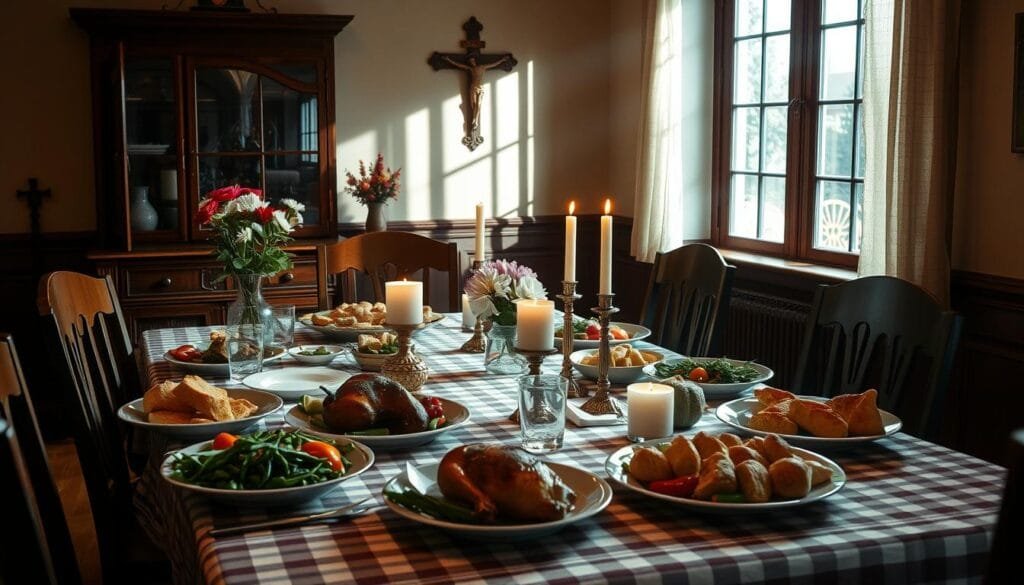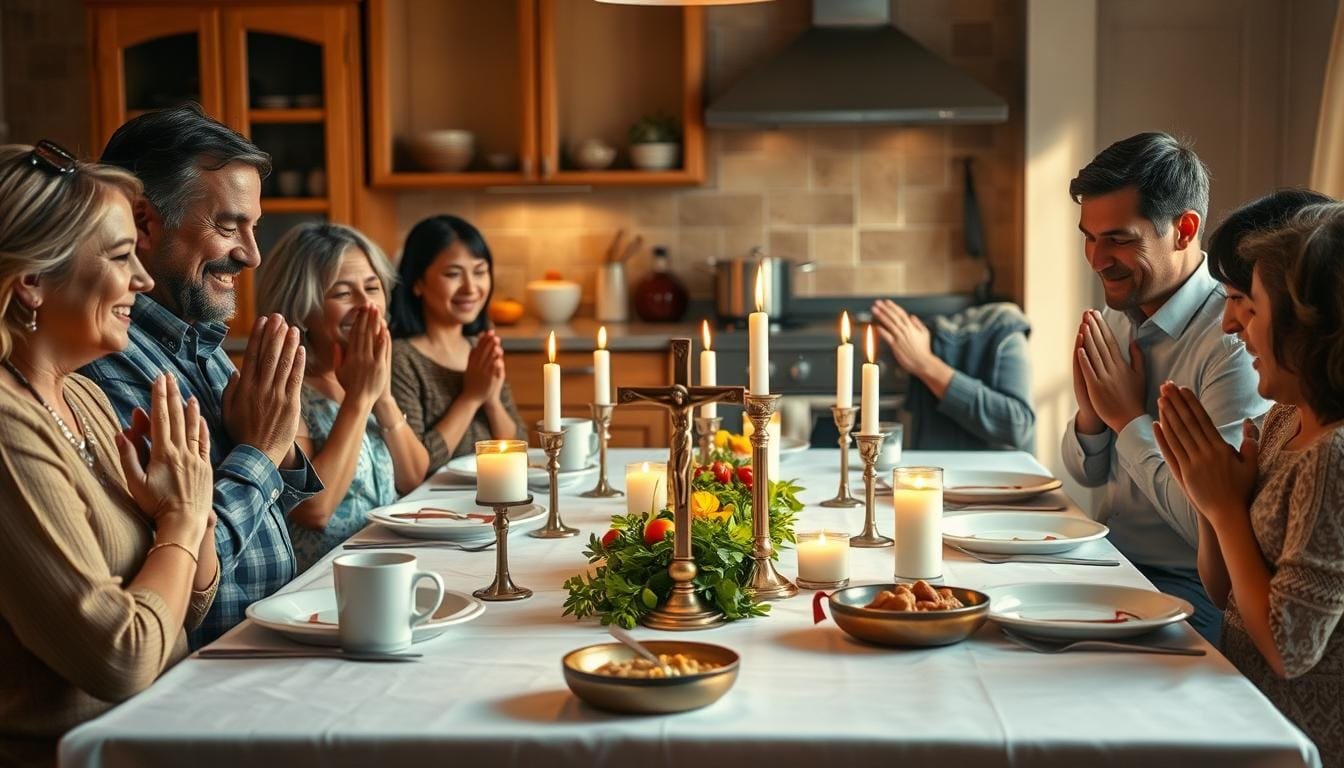Beyond Grace: Catholic Family Dinner Prayers
This website contains affiliate links. As an Amazon Associate, I earn from qualifying purchases. The content on this website was created with the help of AI.
Family dinners hold deep meaning in Catholic homes. They’re more than just eating; they’re sacred moments. The dinner table becomes a space where faith, love, and togetherness blend.
Catholic mealtime prayers have been important for centuries. They offer a chance to pause and show gratitude. These prayers turn simple meals into meaningful rituals.
Family dinner traditions in Catholic homes create lasting memories. They’re a time to share stories and pass down values. These shared moments weave the fabric of family life.
Catholic mealtime prayers enrich our lives and deepen our faith. They help us rediscover the sacredness of family dinners. Breaking bread together becomes a powerful experience.
Key Takeaways
- Catholic family dinner prayers transform meals into sacred moments
- Mealtime prayers date back to the 8th century Gelasian Sacramentary
- Family dinner traditions strengthen bonds and pass down values
- Shared meals significantly boost family bonding
- Prayer before meals opens us to God’s gifts beyond food
- Family dinners foster respect and understanding among differing viewpoints
- Mealtime prayers can be adapted for various life events and celebrations
The Sacred Tradition of Family Meals in Catholic Homes
Family dinners are crucial in Catholic homes. They create lasting connections and nurture faith. The catholic table blessing reminds us to be thankful for our blessings.
Understanding the Historical Significance
Family meals in Catholic culture have deep roots. They echo the Last Supper, where Jesus shared bread and wine with his disciples.
Breaking bread together symbolizes unity within families and the Catholic community. It’s a powerful way to strengthen bonds and share faith.
Creating Meaningful Connections Through Shared Meals
Regular family dinners offer more than just good food. They provide a chance for families to bond and grow in faith together.
Studies show that children who eat with their families often have fewer problems. They also tend to do better in school and have stronger relationships.
| Benefits of Family Dinners | Percentage |
|---|---|
| Families eating dinner together | 50% |
| Families saying grace before meals | 13% |
| Catholic families praying together | 17% |
The Role of Food in Catholic Culture
In Catholic tradition, food is more than just fuel. It’s central to celebrations and religious observances.
From fish on Fridays during Lent to special treats on feast days, our meals reflect our faith. These traditions create a rich tapestry of faith, culture, and love around our tables.
“For where two or three gather in my name, there am I with them.” – Matthew 18:20
Catholic Family Dinner Prayers: A Guide to Traditional Blessings
Catholic table blessings bring families together in gratitude. Our collection of mealtime prayers caters to various occasions and preferences. These blessings range from simple to elaborate.
Our guide features 29 unique prayers reflecting diverse Catholic themes. These prayers foster reverence and community around the dinner table. They include short thanks and longer, poetic blessings.
“Bless us, O Lord, and these Thy gifts, which we are about to receive from Thy bounty. Through Christ our Lord. Amen.”
This Traditional Blessing is popular among Catholic families. It’s brief yet meaningful, ideal for weeknight dinners or special gatherings.
We offer prayers that touch on different aspects of gratitude:
- Thanks for the food and those who prepared it
- Blessings for health and family
- Remembrance of those less fortunate
- Prayers for peace and understanding
| Prayer Type | Focus | Suitable For |
|---|---|---|
| Short Prayer | Quick gratitude | Busy weeknights |
| Formal Dinner Prayer | Elaborate blessing | Special occasions |
| Family Mealtime Prayer | Unity and love | Daily family dinners |
| Psalm Prayer | Biblical reflection | Sunday meals |
Adding these blessings to your routine creates a sacred space for family connection. Praying together can turn a simple meal into a spiritual moment.
It nurtures familial bonding and nourishes the soul.
From Last Supper to Modern Table: The Evolution of Mealtime Prayer
Mealtime prayer has deep roots in Christian history. It traces back to the Last Supper, where Jesus dined with his disciples. This event shaped the catholic family dinner prayers we know today.
Biblical Foundations of Breaking Bread Together
The Gospels recount Jesus sharing meals with others. These stories show the importance of communal dining in early Christian life.
Breaking bread together became a symbol of unity and faith.
Jesus’s Example of Communal Dining
Jesus often taught and fellowshipped during mealtimes. His practice of blessing food before eating inspired our modern mealtime prayers.
The “took, blessed, and broke” rhythm at the Last Supper formed the basis for Communion liturgy.
Modern Applications of Ancient Traditions
Catholics today honor these ancient traditions through mealtime prayers. Many families include Last Supper elements in their dinner rituals.
Some even recreate Jesus’s final meal on Holy Thursday each year.
Catholic mealtime prayers have adapted over time while keeping their core purpose. They remind us of our connection to God and each other.
Saying grace before meals continues a tradition that spans thousands of years.
Creating Sacred Space Around Your Dinner Table
The dinner table is special in Catholic homes. It’s where families share meals, stories, and blessings. By creating a sacred space, everyday meals become meaningful rituals.
Let’s explore how to set the stage for spiritual and physical nourishment.
Setting the Atmosphere for Prayer
A peaceful environment invites reflection and gratitude. Dim the lights or light candles to create a calm atmosphere. Play soft background music to help transition from busy days to focused mealtime.

Incorporating Religious Symbols
Religious symbols remind us of our faith during meals. Place a small crucifix on the table or hang a religious painting nearby. These visual cues reinforce the sacred nature of family gatherings.
Establishing Family Rituals
Consistent rituals make family dinner traditions more meaningful. Consider these ideas:
- Light a special candle before saying grace
- Take turns leading the Catholic table blessing
- Share daily gratitudes before eating
- Read a short scripture passage
These practices can deepen family connections and strengthen faith. The goal is to create a warm, inviting space for sharing and growing together.
| Family Dinner Tradition | Benefits |
|---|---|
| Saying grace together | Expresses gratitude, teaches prayer |
| No phones at the table | Encourages conversation, reduces distractions |
| Sharing highs and lows of the day | Builds empathy, improves communication |
| Taking turns setting the table | Teaches responsibility, involves everyone |
Creating a sacred space around your dinner table nurtures your family’s faith. It strengthens bonds that will last a lifetime. You’re not just sharing a meal but building a spiritual foundation.
Building Family Unity Through Shared Meals
Family dinner traditions bring us together, fostering unity and creating lasting memories. Kids who dine with parents often have higher self-esteem and better thinking skills.
These shared moments contribute to improved academic achievement and lower risks of depression among children.
Shared meals boost emotional closeness and strengthen relationships. Many families report increased quality time together during challenging times.
Regular family dinners have proven beneficial for both adults and children alike.
Catholic family dinner prayers add a sacred dimension to these gatherings. They transform the dinner table into an extension of the church altar.
These prayers nurture love, gratitude, and faith within the family unit.
Family meals became even more crucial during the COVID-19 pandemic. A study of 731 U.S. adults showed that regular family dinners increased emotional closeness.
“Family dinner plus prayer was a sacred time of grace.”
To enhance your family dinner experience, consider these simple steps:
- Set a consistent dinner schedule
- Involve everyone in meal preparation
- Start with a meaningful prayer
- Share highlights from your day
- Express gratitude for each other
Prioritizing shared meals invests in our family’s well-being. It creates a lasting sense of belonging and stability. These moments around the table will be cherished for years to come.
Teaching Children the Value of Mealtime Blessings
Catholic homes cherish the tradition of mealtime prayers. Teaching kids to appreciate catholic table blessings helps foster gratitude.
It also strengthens family bonds and nurtures spiritual growth.
Age-Appropriate Prayer Practices
Simple, memorized prayers work best for younger children. As kids grow older, we can introduce more interactive mealtime prayers.
This approach helps children understand and engage with the practice naturally.

Making Grace Interactive and Meaningful
To make grace more engaging, we can:
- Rotate prayer responsibilities among family members
- Encourage children to express what they’re thankful for
- Use creative prayer methods to avoid repetition
Fostering Gratitude in Young Hearts
Regular family meals with blessings can profoundly affect children’s lives. Research shows positive impacts on kids who join family dinners regularly.
| Benefit | Impact |
|---|---|
| Academic Performance | Better school results |
| Social Behavior | Fewer anti-social tendencies |
| Peer Relationships | More successful with peers |
| Education | Higher high school graduation rates |
| Risk Behaviors | Less likely to engage in smoking, alcohol, drugs, or early sexual activity |
These practices create a sacred space at our dinner table. They nurture our children’s spiritual growth. A deep sense of gratitude blossoms through these meaningful moments.
Overcoming Modern Challenges to Family Dinner Time
Keeping family dinner traditions alive can be hard in our fast-paced world. Busy schedules and digital distractions often interfere with quality table time.
These moments are vital for strengthening family bonds and practicing Catholic family dinner prayers.
Managing Busy Schedules
Many families juggle long work hours, after-school activities, and lengthy commutes. To address this, we can set specific dinner times. Prioritizing family meals over other activities is also crucial.
When possible, consider flexible work arrangements to make time for family dinners.
- Set specific dinner times
- Prioritize family meals over other activities
- Consider flexible work arrangements when possible
Dealing with Digital Distractions
Screens often vie for our attention during meals. Try establishing a “no phones at the table” rule. Keep TVs and computers off during dinner time.
Use this time for face-to-face communication with your family members.
- Establish a “no phones at the table” rule
- Keep TVs and computers off during dinner
- Use this time for face-to-face communication
Creating Consistent Dinner Routines
Consistency is key to preserving family dinner traditions. Start with a Catholic family dinner prayer. Share the highs and lows of the day with each other.
Read a chapter from a book together or discuss faith and virtues as a family.
- Start with a catholic family dinner prayer
- Share the highs and lows of the day
- Read a chapter from a book together
- Discuss faith and virtues as a family
By making these efforts, we can keep the sacred tradition of family dinners alive. It’s worth creating lasting memories and strengthening family bonds around the dinner table.
Conclusion
Catholic family dinner prayers are vital for faith and togetherness. They turn ordinary meals into sacred moments. These prayers foster gratitude and strengthen family bonds.
Family dinner traditions differ across denominations. The Latin Catholic “Bless us, O Lord…” is one example.
The Lutheran “Common Table Prayer” is another. These customs enrich our spiritual lives and create lasting memories.
Modern life presents challenges to maintaining these traditions. Setting aside time for family meals is crucial. Incorporating catholic family dinner prayers creates a sacred space at home.
This practice nurtures our faith and teaches children valuable lessons. It shows the importance of gratitude and community. These meals reflect the communal spirit of Jesus and his disciples.













